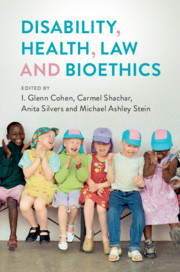Book contents
- Disability, Health, Law, and Bioethics
- Disability, Health, Law, and Bioethics
- Copyright page
- Dedication
- Contents
- Notes on Contributors
- Introduction
- Preface
- Acknowledgments
- Part I Disability: Definitions and Theories
- Part II Disability in the Beginning and the End of Life
- Introduction to Part II
- 4 Abortion, the Disabilities of Pregnancy, and the Dignity of Risk
- 5 The Down Syndrome Information Act and “Mere Difference”: Redefining the Scope of Prenatal Testing Conversations?
- 6 Dementia, Disability, and Advance Medical Directives: Defensible Standards for Dementia Care
- Part III Disability in the Clinical Setting
- Part IV Equality, Expertise, and Access
- Part V Disability, Intersectionality, and Social Movements
- Part VI Quantifying Disability
Introduction to Part II
from Part II - Disability in the Beginning and the End of Life
Published online by Cambridge University Press: 08 April 2020
- Disability, Health, Law, and Bioethics
- Disability, Health, Law, and Bioethics
- Copyright page
- Dedication
- Contents
- Notes on Contributors
- Introduction
- Preface
- Acknowledgments
- Part I Disability: Definitions and Theories
- Part II Disability in the Beginning and the End of Life
- Introduction to Part II
- 4 Abortion, the Disabilities of Pregnancy, and the Dignity of Risk
- 5 The Down Syndrome Information Act and “Mere Difference”: Redefining the Scope of Prenatal Testing Conversations?
- 6 Dementia, Disability, and Advance Medical Directives: Defensible Standards for Dementia Care
- Part III Disability in the Clinical Setting
- Part IV Equality, Expertise, and Access
- Part V Disability, Intersectionality, and Social Movements
- Part VI Quantifying Disability
Summary
The late singer-poet-novelist Leonard Cohen entitled one book of verse Let Us Compare Mythologies. In a sense, all of the chapters in this Part ask us to do exactly that. I do not mean “mythology” in a pejorative sense, but in all its anthropological splendor: taking facts on the ground and understanding them as part of a coherent sense-making worldview, albeit one that may not be falsifiable in a standard sense. But if that still seems pejorative, perhaps we might instead say “Let Us Compare View-Masters,” a reference to the red stereoscopic viewers that have delighted children (and adults) for decades by allowing us to enter static renderings with depth perception of lands real and imagined.
- Type
- Chapter
- Information
- Disability, Health, Law, and Bioethics , pp. 49 - 50Publisher: Cambridge University PressPrint publication year: 2020

